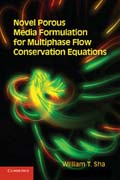
Novel Porous Media Formulation for Multiphase Flow Conservation Equations
Sha, William T.
William T. Sha first proposed the novel porous media formulation in an article in Nuclear Engineering and Design in 1980. The novel porous media formulation represented a new, flexible and unified approach to solve real-world engineering problems. It uses the concept of volume porosity, directional surface porosities, distributed resistance and distributed heat source and sink. Most practical engineering problems involve many complex shapes and sizes of solid internal structures whose distributed resistance is impossible to quantify accurately. The concept of directional surface porosities eliminates the sole reliance on empirical estimation of the distributed resistance of complex-shaped structures often involved in the analysis. The directional surface porosities thus greatly improve the resolution and modeling accuracy and facilitate mock-ups of numerical simulation models of real engineering systems. Both the continuum and conventional porous media formulations are subsets of the novel porous media formulation. INDICE: 1. Introduction; 2. Averaging relations; 3. Phasic conservation equations and interfacial balance equations; 4. Local-volume-averaged conservation equations and interfacial balance equations; 5. Time averaging of local-volume-averaged conservation equations or time-volume-averaged conservation equations and interfacial balance equations; 6. Time averaging in relation to local volume averaging and time-volume averaging versus volume-time averaging; 7. COMMIX code capable of computing detailed micro-flow fields with fine computational mesh and high-order differencing scheme; 8. Discussion and concluding remarks.
- ISBN: 978-1-107-63017-8
- Editorial: Cambridge University Press
- Encuadernacion: Rústica
- Páginas: 260
- Fecha Publicación: 02/01/2014
- Nº Volúmenes: 1
- Idioma: Inglés
